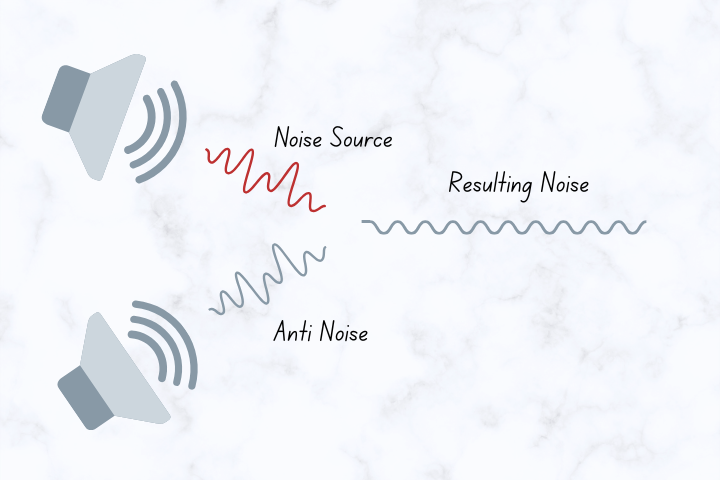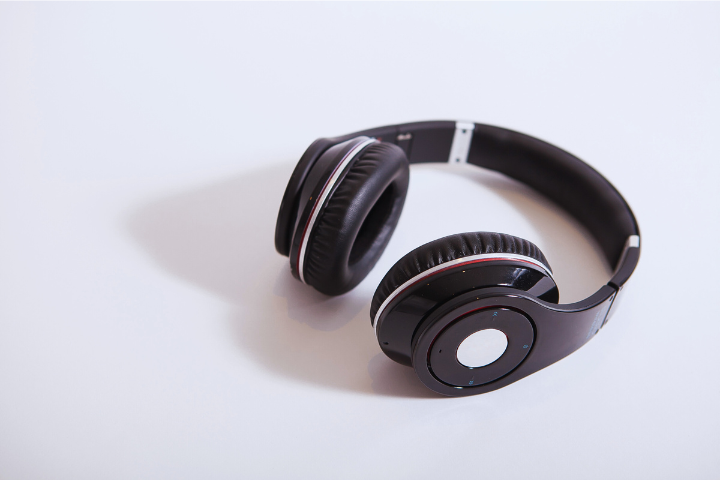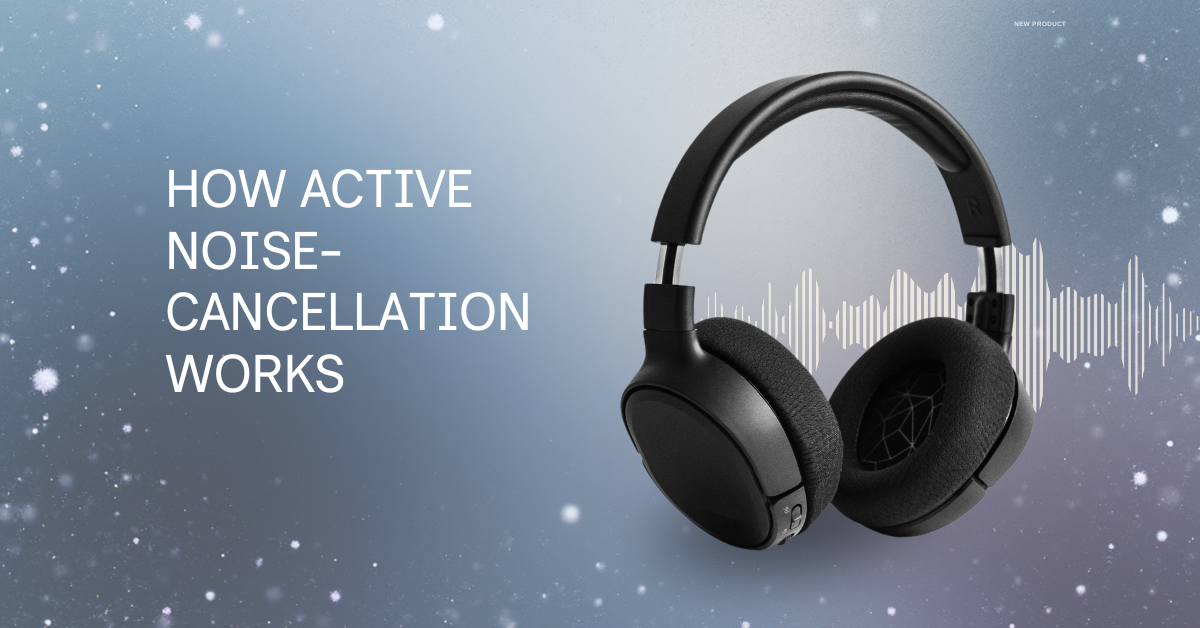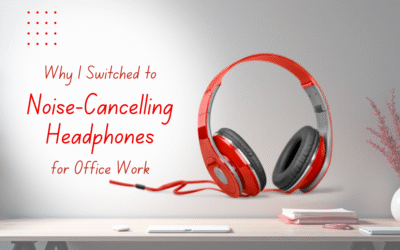Summary: “Active Noise Cancellation (ANC) uses microphones to capture ambient sounds. It then generates anti-noise waves. This process minimises unwanted background noise. Found primarily in earphones and speakers, as well as headphones. It is effective with low-level noise. However, it makes headphones heavier. ANC also offers clearer sound. But it performs worse with high-pitched sounds.”
Nowadays, Active Noise Cancellation (ANC) is changing how we experience audio. The ANC operation helps you eliminate unwanted background noise. As a result, you can better hear the sound signal you want to listen to. It’s especially helpful in the kind of noisy places, like an office or a train, where it can be difficult to concentrate.
ANC microphones pick up external noise and generate a sound wave to cancel it out. This makes for a more immersive experience, whether you’re listening to music, on calls, podcasts, or simply seeking some tranquillity.
But how does ANC work? This guide explores the science behind ANC, examines its application in headphones, earbuds, and speakers, and offers advice on choosing the best ANC products for your needs.
What is Active Noise-Cancellation (ANC)?
What is ANC? Active Noise-Cancellation eliminates unwanted background noise. Unlike regular headphones, which block noise passively by physically shielding your ears, ANC uses electronics to counteract ambient sound.
It does so using the device’s microphones (headphones or speakers) to listen for external sounds. The device then generates a reverse sound wave and plays it through the speakers. When the two waves meet, they cancel each other out due to destructive interference.
This means a more focused, distraction-free listening experience. ANC is particularly good at blocking out low-frequency, steady sounds, such as engine hums, air conditioning, and traffic noise. But they may not be as effective with short, high-frequency sounds, such as human speech and sirens.

How Does Active Noise-Cancellation Work?
Even though the science behind Active Noise-Cancellation (ANC) technology might seem complex, it is actually quite simple. It works by cancelling noise with a counteracting sound. Here’s a closer look at how ANC functions:
1. Microphones Detect the Noise
At the centre of any ANC system are its microphones. Embedded in the headphones, earbuds, or speaker system are small sensors. They are always continuously listening to what you hear.
The microphones also capture unwanted noises from your environment, like the drone of aeroplane engines, the whir of an air conditioner, or conversations in a crowded coffee shop. The more advanced the device, the better these microphones can capture even subtle sounds in the environment.
2. Sound Wave Inversion
After calculating background noise from microphones, the ANC (active noise control) method filters out all harmful signals. It creates an anti-noise sound wave, which is the inverse of the noise it detected. This is sometimes called making “anti-noise.”
The anti-noise sound wave is exactly out of phase, so that the peaks and troughs are opposite. When the original sound and the anti-noise wave are combined, they cancel each other out. This occurs due to destructive interference.
3. Noise Reduction and Sound Clarity
This behaviour helps reduce distractions from the “Noise Chapter” and provides you with a much quieter listening experience. While ANC doesn’t fully eliminate all external noise, it excels at reducing low-frequency, constant sounds. For instance, if you’re sitting on an aeroplane with the constant hum of the engines, ANC technology can effectively cancel that noise, leaving you with a quieter environment.
However, when it comes to sporadic, high-pitched sounds — like human speech or the crash of dishes — ANC isn’t as effective. Despite these limitations, people continue to embrace the technology because its benefits far outweigh any technical flaws.
4. Customizable Noise Control
Certain ANC headsets now offer adjustable noise cancellation levels. You can tune the amount of outside interference you want to block out for different situations. For example, when on the move, people prefer a high ANC setting to block all the noise on an aeroplane.
However, if you’re sitting in your favourite coffee shop, you may want to hear important sounds or conversations. In that case, you can turn down ANC completely or switch to off mode. Some headsets also offer a through-the-press mode that lets external sounds pass through.
Types of ANC Technology
Not all ANC technology is the same. There are currently two main types:
Standard ANC: This kind works by generating a constant anti-noise signal. It primarily cancels low-frequency voices, such as those of engines and air conditioning systems.
Adaptive ANC: It is a more modern and intelligent type of system. It adapts in real time to different sorts of sounds around you. Ideal for dynamic environments where noise intensity changes frequently.
How ANC Works in Different Devices
ANC in Headphones

Headphone is the most common place for active noise-cancelling (ANC) technology. Whether you’re listening to music or having a meeting, this technology will improve your sound quality by blocking outside noise.
The likes of Sony, Bose, and Sennheiser are loved by music enthusiasts seeking a high-quality pair of headphones with advanced ANC.
- Benefits: Great for long flights, busy offices, and noisy environs, it also means you won’t have to hear above current noise pollution.
- Drawbacks: It can add weight to headphones, and some models may experience sound distortion at high volume.
ANC in Earbuds
ANC is now also being incorporated into earplugs. In this way, it can provide portability without any fabric at all, and without sacrificing safe noise-cancelling performance. In-ear ANC works roughly the same way as larger headsets, but its effect is often weaker due to size limitations.
However, better and well-placed components, such as microphones, have made noise-cancelling earbuds a strong option for those on the move.
- Benefits: Small, lightweight, easy to transport, suitable for home use or jogging.
- Drawbacks: May not achieve the noise reduction level promised by over-ear models.
ANC in Speakers
Though ANC is widely known because it is available on other ear and head phones, music with ANC but in speakers remains an infant technology.
Bluetooth speakers with ANC can adapt to their surroundings and cancel out those strident noises. Nevertheless, due to the size and design of speakers, ANC isn’t as effective as with headphones or earbuds.
- Benefits: Great for use at home or for outside tasks.
- Drawbacks: Less effective than headphones in high-frequency noise-gating (as we have seen above).
“Do you need headphones that can handle harsh environments? Check out our Top Picks for the Best Headphones for Construction Workers for durable options.“
Conclusion
Active Noise Cancellation technology has changed how we hear music and do our work. This technology also lets us escape the chaos outside. ANC for headphones and earbuds has a decades-long track record. The future looks bright for ANC in speakers.
Whatever your needs—ANC headphones for travel or earbuds with a handset for commutes—you have plenty of options. After the break, discover ANC tech advances and pick a device that fits your lifestyle to enhance your audio experience.
Post on Oct 17, 2025





0 Comments